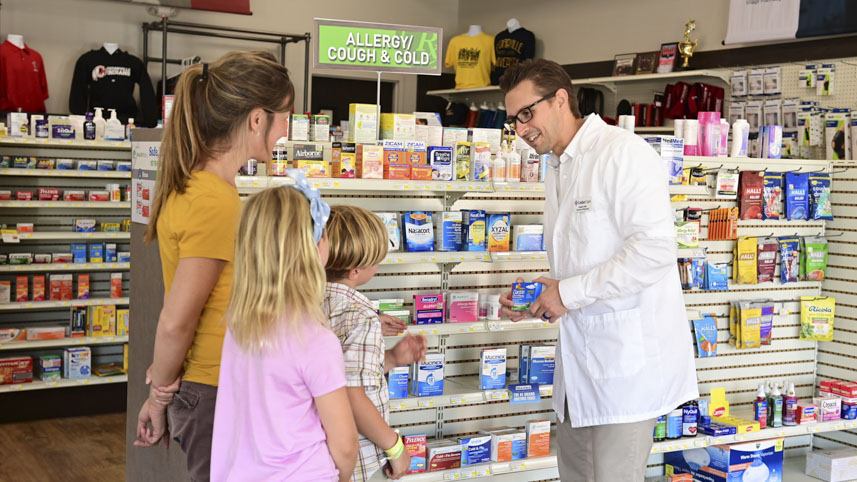by Thad Franz and Justin Coby
In today’s culture, we are led to believe that “bigger is better.” Is that the reality when it comes to how pharmacies serve the general public?
Could there be a growing trend toward more personal care from the old-fashioned community pharmacies in our country? 
Back when our parents or grandparents were in their prime, pharmacies in small-town America were thriving. Today, community pharmacies remain an option, but their functions have drastically changed over the past 100 years.
Back in the 1920s, according to PubMed Central, pharmacies were more of a place for soda fountains and conversations. Move forward another 30 years, and they evolved into what is described as the “lick, stick, pour and more era.”
Those days may be gone forever.
But in more modern years, starting with the 1980s, pharmacies provided more of a pharmaceutical care service to their clientele. This is still true today but with a slight twist: Today’s community pharmacies are now focusing more on providing strategic and managed health care.
With the transformation of local pharmacies, is small-town America better served, or are they still asking what people in rural America should do when they face health issues? Should they drive to the small community pharmacy to pick up cough medicine or get a flu shot?
It might be more efficient for a growing population to see a community pharmacist given that doctors’ schedules are likely booked full, and your next doctor’s appointment is not for another four months.
Or, what if you run out of your glucose test strips and your prescription has no refills? What are you to do?
In many rural towns across this country, especially those in flyover country, you will find community pharmacies as the healthcare headquarters for patients’ needs. Today’s pharmacists are not like your parents’ pharmacists; they now serve a greater need in small and big communities.
Pharmacists today are not just pill pushers but are accessible healthcare providers who are medication experts. They provide recommendations for cold symptoms, like cough and congestion; they immunize against the flu and many other viruses, and they can provide supplies and services for diabetic patients.
Many pharmacies today have pushed well past the dispensing counter to be a one-stop shop for all the health care needs of the community.
What has driven this change in the pharmacy profession? The most obvious is the effect of COVID on health care in general. During the pandemic, people were searching for medical help with the virus. The U.S. government relaxed the restrictions that handcuffed pharmacists to the point where they became a necessity during the pandemic.
Another reason for this change is because of the demand for primary care services with an aging population. Combine that with pharmacists who are trained to assess a patient’s health status and manage a patient’s medication regimen, and pharmacists are being looked at as care providers and being compensated for those services.
The result is better health care for the American population as pharmacists are now a part of the medical team with doctors, nurses, and physician assistants.
This reality is being played out in hometown pharmacies across the country, including at CedarCare Village Pharmacy, in Cedarville Ohio -- the teaching pharmacy at Cedarville University.
At CedarCare Village Pharmacy, pharmacists often are asked to describe the difference between a one-location community pharmacy versus the large chain retail pharmacies. On the surface, the answer seems as logical as comparing a speed boat to an ocean liner. Both are important; however, the community pharmacy is better equipped to change course, when needed.
A recent example of this came just a few months ago when the Federal Drug Administration (FDA) approved pharmacists to prescribe Paxlovid, an antiviral for the treatment of COVID-19. The ability for pharmacists to prescribe this medication was made contingent upon testing, lab work evaluation, and medication review within a five-day window, which brought with it many logistical barriers.
Utilizing relationships and assets that it was able to attain quickly, CedarCare has been able to prescribe this antiviral to those in its rural area who would otherwise not have been able to navigate the health care system in time to be treated. This is just one example of the many ways community pharmacies can step up in times of great need.
Located in southwest Ohio, Cedarville University is an accredited, Christ-centered, Baptist institution with an enrollment of 5,082 undergraduate, graduate, and dual-enrolled high school students in more than 175 areas of study. Founded in 1887, Cedarville is one of the largest private universities in Ohio, recognized nationally for its authentic Christian community, rigorous academic programs, including the Doctor of Pharmacy high graduation and retention rates, accredited professional and health science offerings, and the #4 national ranking by the Wall Street Journal for student engagement. For more information about the University, visit cedarville.edu.


















